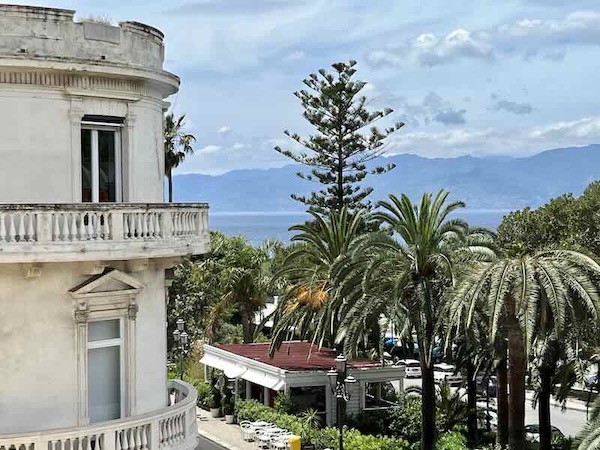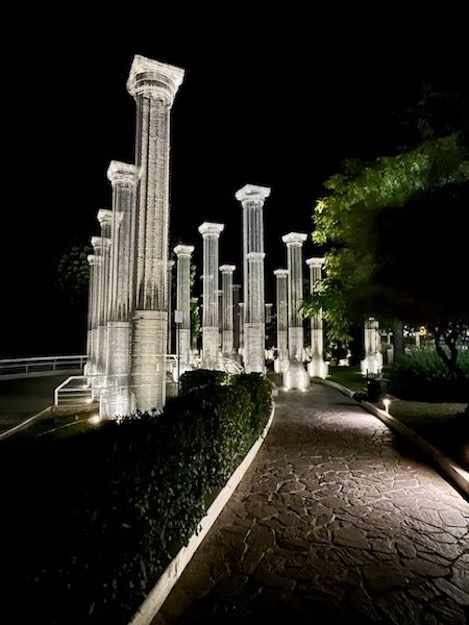Calabria is synonymous with spectacular landscapes and outstanding cuisine. Visitors flock to the region in the toe of the Italian boot for its beautiful beaches and even to visit the Riace Bronzes, expecting to soak up a bit of ancient culture along with a few rays and a lot of great food. But contemporary art? Yes, you can catch that, too, including sculptures by the up-and-coming Edoardo Tresoldi.
WHO IS EDOARDO TRESOLDI?
An Italian artist originally from Milan, Edoardo Tresoldi was born in 1987 and has already made a name for himself on national and international levels. Honors include the Gold Medal for Italian Architecture in 2016 and selection for Forbes’ “30 under 30” list of notable European artists the following year.
Tresoldi is celebrated for his sculptures in wire mesh. These semi-transparent creations range from more modest pieces to large-scale installations. In one of his best-known works, the Basilica di Siponto, he recreated an Early Christian Basilica out of mesh in Manfredonia, Province of Foggia. The contemporary structure sits over an archeological site’s ancient ruins next to a Romanesque church built 600 years later. You can read more about this work, commissioned by Puglia’s Ministry of Culture, on my friend Cristina’s blog, Un po’ di pepe.
EDOARDO TRESOLDI IN PIZZO
Tresoldi’s first pieces in wire mesh focused on the human form, and one of his earliest public works is in Pizzo, Calabria, a picturesque seaside town known for the demise of Joachim Murat and a delicious gelato treat, the Tartufo di Pizzo. Tresoldi characterizes his sculpture with the name Il Collezionista di Venti (The Collector of Winds). This Uomo dei Venti or Man of the Winds as he is also called, sits on a ledge just below the Aragon castle and the main square of the old town, Piazza della Repubblica. From this spot, there’s a splendid view of the Gulf of St. Eufemia out to the Aeolian Islands, and the “collector” looks out towards the Tyrrhenian Sea, facing the wind and the beautiful sunsets, granted to all those who choose to pause and appreciate the panoramas along this part of Italy’s southwestern coastline.
“There isn’t a wind that hasn’t chatted with him,” comments the artist. Tresoldi sees the transparency of the figure as lending a phantom-like nature to the sculpture, not forcing himself on the location but giving a nod to his presence. The figure sits in a relaxed pose with his sleeves rolled up, almost as if he has returned from a day of fishing. He reposes to contemplate his existence.
Il Collezionista di Venti immediately spoke to the viewing public upon installation and continues to catch the eye and invoke curiosity in those who pass, even becoming a raison d’être for a visit to Pizzo by tourists and photographers. I like il Collezionista.
EDOARDO TRESOLDI IN REGGIO CALABRIA
Reggio Calabria, the region’s largest city in the very south of the Italian peninsula, has a lot to offer visitors and residents with regard to visuals. The art and artifacts, highlighted by the Riace Bronzes at the city’s archeological museum, are stunning. The Liberty-style architecture is attractive and graceful, and the setting is world class. Location, location, location – Reggio’s lungomare (seafront) not only features a beautiful park, but it’s situated along the storied Strait of Messina with Sicily and its mountains just across the water.
The scene is set for Opera, not a dramatic piece for singers and orchestra, but simply the “work” or creative work. Commissioned by the City of Reggio Calabria in 2018 and unveiled in 2020, Opera “was created to celebrate the contemplative relationship between place and human beings through the language of classical architecture and the transparency of the Absent Matter. The open wire-mesh structure offers a new monument fully crossable and accessible to locals and visitors alike.”
The installation is large, 46 columns with a height of 8 meters each, over a 2,500 square-meter area (that’s 2/3 of an acre). They’re lit at night and the effect is quite lovely. Reggio is a city with a lively passeggiata culture. Previously along the promenade, there were the trees, the strait, and the twinkling lights of Messina. Now, there are also the columns, which remind passersby of the city’s ancient history.
During the day, the columns are less appealing. Tresoldi asserts that the choice of classical architecture will lead to the exploration of “new visual poetics in dialogue with the surroundings and the viewer…. allowing for a further interpretation of the park.” I do not have much success when I attempt to “dialogue” with the reems of wire mesh that aren’t as transparent as I’d like them to be.
OPERA BY EDOARDO TRESOLDI – CONTROVERSY
Needless to say, there has been a lot of controversy regarding the columns. First off, the price tag of 950,000 Euros. Of course, we all understand that money earmarked for such an installation would never be available for filling potholes and taking better care of the exotic plants that already beautify the lungomare. However, it’s a big number and apparently there wasn’t a public call for proposals.
And then came the wind, which is considerable off the strait, and in February 2022, at least two of the columns began to sway and lean with a real chance of falling over. Of course, the possibility for strong winds was supposed to be part of the equation during the construction. Opponents of the columns rigged up a sign “Via col vento,” which by the way is the Italian title of the film Gone with the Wind.
The columns have since been repaired and Opera is a permanent installation along Reggio’s seafront. Perhaps the “work” won’t have the longevity of an ancient temple, but Opera will surely spark dialogue for the foreseeable future. Personally, I would have voted for columns that could have receded into the ground during the day or inclement weather, like barriers in city streets, and come up at night and in good weather.
See these contemporary sculptures on one of my CALABRIA TOURS!
We visit Reggio Calabria on all three itineraries and Pizzo on the Calabria Cultural Tour.
Read all about the fascinating Calabrian region in my book Calabria: The Other Italy, described by Publisher’s Weekly as “an intoxicating blend of humor, joy, and reverence for this area in Italy’s deep south,” and explore Calabria’s northern neighbor in my book Basilicata: Authentic Italy, “recommended to readers who appreciate all things Italian” by the Library Journal.
Follow me on social media: Basilicata Facebook page, Calabria: The Other Italy’s Facebook page, Karen’s Instagram and Karen’s Twitter for beautiful pictures and information.
Sign up below to receive the next blog post directly to your email for free.











Comments 5
Definitely a thought provoking artist & I remember being struck by the columns when I saw them. I agree with you that it would have been better if they could have receded somewhat more during the day but they were quite ethereally evocative at night! Contemporary art is always tricky…
Author
Yes, it doesn’t have the perspective of time.
Wow-Edoardo’s work is so beautiful. Il Collezionista dei Venti is spectacular and looks great from every angle! I love the rolled up shirt sleeves. The columns look beautiful at night, but they are a bit underwhelming during the day. I sure hope they stay erect! I hope you get to see the Basilica in Siponto. it is incredible-i want to see it at night as I heard it is haunting and ghostly. it is hard to get to without a car so don’t know when I’ll be able to get there. My cousin was married at Santa Maria di Siponto in June 2022 so I got to visit again-don’t know if you saw those photos? Thanks for linking to my post, I think a few people actually looked at it! Ciao, Cristina
Author
I love the rolled-up sleeves of the Collezionista as well. Together with the shoulders and the lean, the figure looks so natural. I did see the photos of your cousin’s wedding – amazing, looked like being on the set of a foreign film, but it was real! Public transportation can certainly be a challenge in Italy, but when I try to imagine going anywhere in the US outside a big city without a car, it puts it all into perspective.
Edoardo Tresoldi’s sculptures in Calabria, like *Il Collezionista di Venti* in Pizzo and *Opera* in Reggio Calabria, beautifully merge contemporary art with the region’s natural and historical charm. His ethereal wire-mesh designs, from the contemplative *Man of the Winds* overlooking the Tyrrhenian Sea to the striking columns of *Opera* on the Reggio seafront, create a unique dialogue between past and present. These installations not only celebrate Calabria’s cultural landscape but also inspire reflection on humanity’s relationship with its surroundings. Thank you for highlighting how modern art enriches this remarkable region!